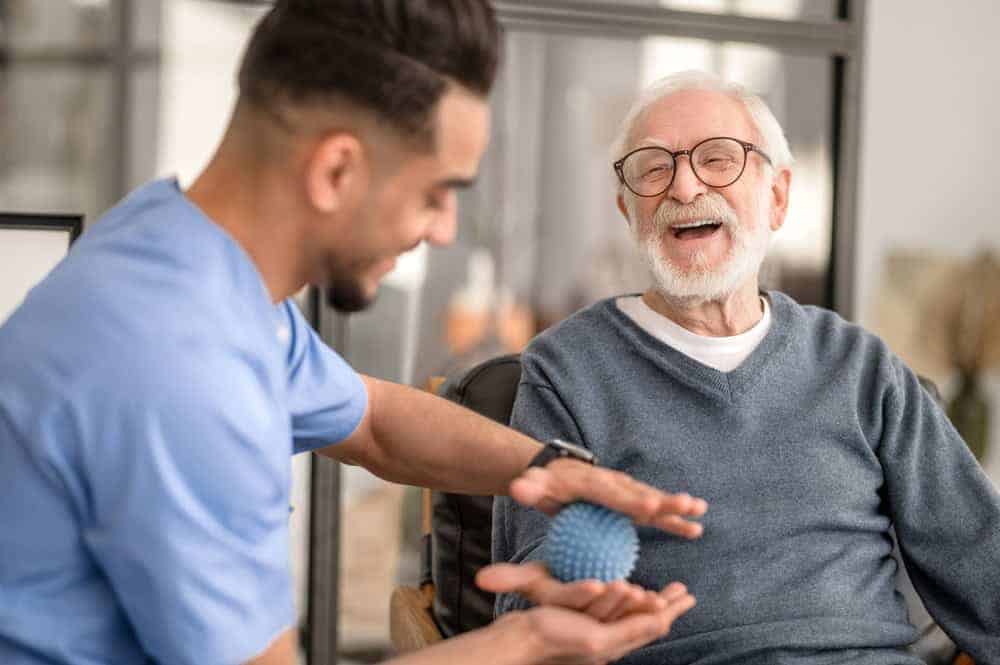The words of Joseph Pilates, the founder of Pilates, resonate deeply in the context of aging: ‘One is as young as one’s spine. If your spine is stiff at 30, you are old; if it is flexible at 60, you are young.’ This underscores the crucial role of physical therapists in senior care, as they help maintain and restore mobility, a key factor in aging well.
Today, we know how important the ability to move freely is for our quality of life. In modern society, the prevalence of a sedentary lifestyle brings an array of issues that multiply and get more severe as we age. Women begin to lose muscle mass and bone density around the age of 40, and while this process occurs somewhat slower in men, by the time we reach our 60s, reversing the effects of inactivity becomes significantly more challenging.
Later in life, loss of muscle strength and agility can be exacerbated by several other health problems or accidents that may leave us bed-stranded for a while. Physical therapists (PTs) are specialists who can help us restore our bodies’ mobility.
As the number of older adults grows, the demand for physical therapists will continue to rise. The need for physical therapy in senior care grows because PTs help older adults manage health problems, get better after treatments, avoid falling, and stay active and on their own.

This article explores
- The role of physical therapists in senior care,
- The path to becoming a doctor of physical therapy,
- Some advancements in PT, and
- The future of PT
The Role of Physical Therapists in Senior Care
Physical therapists play an essential role in senior care such as:
Managing Health Problems
As people get older, they’re more likely to have ongoing health issues like arthritis (joint pain), diabetes (high blood sugar), heart problems, and trouble breathing. The role of physical therapists (PTs) in managing these problems becomes increasingly crucial.
They work to keep seniors moving well so they can do daily activities by themselves, and have effective ways to manage pain without using lots of medicine. This is not just a profession, but a vital service that significantly improves the quality of life for seniors.

Aiding the Post-Surgery or Illness Recovery
Seniors often need physical therapy to get better after surgeries, like getting new joints, healing from broken bones, recovering from strokes (brain problems), or heart issues. PTs help them regain their strength, move better, and do things they used to do.
Preventing Falls
Older adults often face the risk of accidents and falls due to poor coordination and balance. Falls are a significant concern for older adults as they can lead to severe injuries and hospitalization. PTs play a pivotal role in designing programs that enhance seniors’ balance, strength, and mobility. By adhering to these programs, seniors can significantly reduce their risk of falling and getting injured.

Offering Physical Therapy in Various Settings
It is important to have access to physical therapy in different places, as traveling can be an issue for some seniors. Many seniors prefer physical therapy at home because it’s more comfortable. PTs visit them there to give them the care they need.
All reputable senior care facilities like Amy’s Eden Senior Care also need PTs to help people stay healthy and live quality lives. Some seniors go to clinics for physical therapy to manage persistent health problems or to get better after surgeries. The ability to provide physical therapy in various settings not only ensures accessibility but also plays a significant role in maintaining seniors’ independence and quality of life.
Doctor of Physical Therapy (DPT): The Gold Standard in Physical Therapy Education
The Doctor of Physical Therapy (DPT) degree is the highest standard for physical therapy education. This doctoral degree prepares students to become licensed physical therapists with the skills and knowledge to diagnose and treat patients with various physical challenges. Completing a DPT program typically takes three years after earning a bachelor’s degree and includes classroom learning and hands-on clinical experience.
The American Physical Therapy Association (APTA) sets the standards for physical therapy education in the United States. Its Commission on Accreditation in Physical Therapy Education (CAPTE) accredits DPT programs, ensuring they meet high educational standards and produce competent physical therapists.
Accreditation by CAPTE is essential because it means the program meets nationally recognized quality standardsgraduates must takeo take the National Physical Therapy Examination (NPTE).
The Path to Becoming a Doctor of Physical Therapy
The journey to becoming a Doctor of Physical Therapy entails meeting specific prerequisites, fulfilling competitive admission requirementsfully completing a rigorous DPT program. This comprehensive process ensures that only the most dedicated and qualified individuals enter the field of physical therapy.
Prerequisite Courses
Before applying to a Doctor of Physical Therapy (DPT) program, students must typically complete a bachelor’s degree and certain prerequisite courses. These prerequisites ensure that applicants have a foundational knowledge essential for success in a DPT program.
Commonly required prerequisite courses are:
- Anatomy and Physiology: Typically, two semesters covering the structure and function of the human body.
- Biology: Introductory courses in general biology, often including lab components.
- Chemistry: Two semesters of general chemistry with lab work.
- Physics: Two semesters covering fundamental physics principles, often with a focus on mechanics and electromagnetism, and including lab work.
- Psychology: Introductory psychology courses, with some programs requiring additional courses such as developmental or abnormal psychology.
- Statistics: A course covering basic statistical methods and their applications.
Admission Requirements for DPT Programs
Admission to DPT programs is highly competitive and involves several key requirements beyond completing prerequisite coursework.
- Bachelor’s degree: All applicants must have completed a bachelor’s degree from an accredited institution.
- GPA Score: Most programs have a minimum GPA requirement, often around 3.0, though competitive applicants typically have higher GPAs.
- GRE Achievement: Some programs require the Graduate Record Examination (GRE) scores, with specific minimum scores varying by program.
- Observation Hours: Applicants usually need to complete a certain number of observation or volunteer hours under the supervision of a licensed physical therapist. These hours provide insight into the profession and demonstrate commitment.
- Letters of Recommendation: Typically, programs require two to three letters of recommendation, often from academic professors, physical therapists, or other healthcare professionals.
- Personal Statement: A written essay that outlines the applicant’s motivation for becoming a physical therapist, relevant experiences, and career goals.
- Interviews: Some programs require an interview as part of the admission process to assess the applicant’s interpersonal skills, professionalism, and fit for the program.
Educational Experience During a DPT Program
Once admitted, students embark on a rigorous educational journey that combines classroom instruction, lab work, and clinical experiences. The DPT curriculum is designed to develop comprehensive skills and knowledge in physical therapy, equipping students with the necessary tools and confidence to excel in their future careers.
Core Coursework
The DPT curriculum covers many areas of physical therapy practice. Students study Anatomy and Physiology to understand the human body and its systems and Kinesiology to learn about human movement. Pathophysiology teaches how diseases affect the body, while Neuroscience focuses on the nervous system and its impact on movement and function. Pharmacology provides a basic understanding of medications and their effects on rehabilitation.
Clinical Biomechanics involves analyzing the mechanical aspects of human movement. Evidence-Based Practice teaches students how to apply research to clinical decision-making. Orthopedic Physical Therapy covers the assessment and treatment of musculoskeletal conditions, while Neurological Physical Therapy focuses on managing patients with neurological disorders. Cardiopulmonary Physical Therapy deals with treating patients with heart and lung conditions.

Students also learn about Pediatric and Geriatric Physical Therapy, which involves specialized care for children and older adults. They study Health Care Systems to understand the context of physical therapy practice within the healthcare system. Therapeutic Interventions include instruction in therapeutic exercise, manual therapy techniques, and various treatment methods. Professional Practice courses cover ethics, healthcare systems, documentation, and evidence-based practice. Finally, Research Methods teaches students about research design, statistics, and scientific literature evaluation.
Clinical Experience
Clinical education is crucial to DPT programs, offering hands-on training in real-world settings. These experiences are woven throughout the program and culminate in full-time internships. They typically have three main components:
Clinical rotations involve multiple short-term placements in various settings like hospitals, outpatient clinics, rehabilitation centers, and specialty areas such as pediatrics and geriatrics. These rotations give students a broad exposure to different aspects of physical therapy practice.
Internships are long-term, full-time clinical placements where students apply their knowledge and skills under the supervision of licensed physical therapists. These internships allow students to gain deeper, practical experience in a professional setting.
Capstone projects are often required in some programs. These projects can be research-based or involve a comprehensive case study, demonstrating how students integrate and apply the concepts they have learned throughout their studies.

Through a blend of didactic learning and extensive clinical training, DPT programs prepare graduates to enter the field as competent, knowledgeable, and skilled physical therapists (PTs) ready to make a positive impact on patient care and the healthcare system.
Licensed Physical Therapists In Senior Care
Licensed physical therapists play a crucial role in caring for seniors by addressing a wide range of physical health issues through general and specialized practices.
Geriatric Physical Therapy
Physical therapists (PTs) assess and treat conditions common in older adults, such as arthritis, osteoporosis, balance disorders, and joint replacements.
They develop and implement fall prevention programs to improve balance, strength, and coordination, thus reducing the risk of falls.
PTs also assist seniors in maintaining or improving their ability to perform daily activities (ADLs), enhancing their independence and quality of life.

Orthopedic Physical Therapy
PTs help in the recovery process following orthopedic surgeries like hip and knee replacements, aiding seniors in regaining strength and mobility. Using various techniques such as manual therapy, exercises, and modalities like ultrasound and electrical stimulation, PTs can help older adults manage musculoskeletal pain.
Neurological Physical Therapy
For stroke survivors, PTs work to restore movement and function through exercises and neuromuscular re-education. PTs also assist in managing conditions like Parkinson’s disease and multiple sclerosis, focusing on maintaining mobility and function.
Cardiopulmonary Physical Therapy
PTs help seniors with chronic heart and lung conditions improve their endurance and overall physical function through targeted exercises. Seniors recovering from cardiac arrests or surgeries benefit from working with PTs who promote cardiovascular health through monitored exercise programs.
Palliative and Hospice Care
In palliative care, PTs work to improve the quality of life for seniors by managing pain and supporting them in maintaining as much mobility and independence as possible. This work helps seniors stay comfortable and maintain their dignity during serious illness.
In all these areas, physical therapists use their expertise to enhance senior patients’ health, mobility, and overall well-being, making a significant difference in their lives.
Working Together to Care for Seniors: Why Teamwork Matters
Interdisciplinary collaboration involves different healthcare professionals working together to provide the best care for our beloved seniors. Physical therapists team up with various specialists to meet the unique needs of older adults.
A holistic approach to care
When healthcare professionals work together, they can conduct thorough check-ups that consider all parts of a senior’s health, including physical, mental, and social factors. This collaboration leads to well-rounded treatment plans that cover all aspects of a senior’s well-being.
Better communication and coordination
Regular team meetings help keep everyone informed about the patient’s progress and needs, while shared electronic health records make it easy to share information, reducing mistakes and ensuring smooth care.
Specialized expertise
Physical therapists collaborate with medical specialists, such as geriatricians, cardiologists, and neurologists, to manage complex health issues. Nurses and social workers also play a vital role in managing medicines, providing home care, and addressing social factors that affect health.
Improved patient outcomes
When healthcare providers work together on care plans, treatments are more effective, reducing hospital visits and improving health. Additionally, interdisciplinary teams provide thorough education and support to help patients and their families manage health conditions better.
Efficient use of resources
Collaboration reduces repeated services and ensures resources are used effectively. Teamwork also helps prevent health problems from worsening, reducing the need for more serious treatments.
5 Essential Advancements in Physical Therapy for Senior Care
Technology has revolutionized many areas of our lives, and physical therapy for seniors is no exception. New technological improvements make physiotherapy treatments more effective and accessible.
- Two key advancements are telehealth and remote monitoring. Telehealth platforms allow seniors to receive physical therapy services from the comfort of their homes, which is especially helpful for those with mobility issues or those living in remote areas. Wearable devices can track physical activity and monitor vital signs, providing real-time feedback to both patients and therapists. This type of monitoring helps PTs personalize treatment plans, react quickly to emergencies, and ensure patients follow their prescribed exercises.
- Gaming technology, like Virtual Reality (VR) and Augmented Reality (AR), can turn rehabilitation exercises into fun activities. These technologies create engaging and enjoyable experiences, encouraging seniors to participate more actively in therapy. Real-life scenario simulations can recreate everyday environments, allowing seniors to practice functional tasks in a safe and controlled setting.

- Robotics and assistive devices also play a crucial role. Robotic exoskeletons help with gait training and mobility, aiding seniors in regaining walking abilities and improving balance. Assistive robots support daily activities, reducing the risk of falls and enhancing independence.
- Electrotherapy and advanced modalities provide additional benefits. Electrical stimulation can be used to relieve pain and strengthen muscles. Laser therapy and ultrasound are effective in reducing pain and inflammation, as well as promoting tissue healing.

- Mobile health apps offer further support. These apps provide instructional videos and reminders for home exercises, ensuring seniors perform their exercises correctly and consistently. They also allow therapists to track progress and adjust treatment plans as needed.
The Future of Physical Therapy in Senior Care
Physiotherapists who specialize in senior care will face both challenges and opportunities in the years ahead as they work to improve the health and quality of life for older adults.
Future Opportunities
- Specialized Expertise
Physiotherapists specializing in senior care have the opportunity to develop expertise in geriatric rehabilitation, oncologic patient rehabilitation, wound management, and other clinical specializations. This in-depth expertise allows PTs to focus on treatments and techniques specifically tailored to the needs of older adults, which can lead to fulfilling and impactful careers.
- Preventive Care Emphasis
There is a growing emphasis on preventive care in geriatrics. Physiotherapists can play a crucial role in designing and implementing exercise programs, fall prevention strategies, and health education initiatives to maintain and improve seniors’ health before serious issues arise.
- Contributing to Research and Innovation
Continued research in geriatric physiotherapy will drive innovation in treatment approaches and rehabilitation techniques. Physiotherapists involved in research can contribute to advancing the field and discovering new methods to enhance mobility, reduce pain, and improve the quality of life for seniors.
- Patient-Centered Care
Providing patient-centered care has already become fundamental in today’s senior physiotherapy. In the future, physiotherapists will continue to prioritize understanding and respecting seniors’ preferences, goals, and values. By involving seniors in decision-making and care planning, physiotherapists can empower them to maintain independence and dignity.
Possible Concerns
- The Increasing Demand for PTs
As the population ages, more seniors will require physiotherapy services to manage conditions like arthritis, osteoporosis, and recovery from surgeries. Physiotherapists will have to manage a larger number of patients while ensuring each of them receives personalized care.
- Adapting to Technology
Integrating new technologies such as telehealth, virtual reality, and wearable devices presents both opportunities and challenges. Physiotherapists must stay updated with technological advancements and learn how to incorporate these tools into their practice to enhance treatment outcomes and improve accessibility for seniors.

- Specialization and Ultra-specialization
Specialization in physical therapy offers great promises but also raises some issues. While patients become more aware of the benefits of physical therapy and seek therapists who specialize in their specific health concerns, whether it’s recovering from sports injuries, managing chronic pain, or improving mobility after surgery, it might prove to be more challenging to provide people in rural areas with access to specialized therapists, especially for less common conditions.
Recap of the Value of PTs in Senior Care
The Doctor of Physical Therapy degree holds significant value in addressing the healthcare needs of a rapidly growing elderly population.
With advancing age, seniors often encounter a range of chronic health issues such as arthritis, diabetes, cardiovascular diseases, and respiratory ailments. These conditions can severely impact their mobility, independence, and overall quality of life.
DPTs specializing in geriatric care are uniquely trained to manage these complex health challenges through targeted rehabilitation strategies.
- One of the primary roles of physical therapists in senior care is to help older adults maintain or regain their mobility and functional abilities. This involves designing personalized treatment plans that include therapeutic exercises, manual therapy techniques, and modalities aimed at improving strength, flexibility, and balance. By enhancing these physical capacities, PTs enable seniors to perform daily activities independently, reducing their reliance on caregivers and enhancing their sense of autonomy.
- Post-surgery or illness recovery is another critical area where PTs play a vital role. Many seniors undergo surgical procedures such as joint replacements, fracture repairs, stroke rehabilitation, or cardiac interventions. Physical therapy is essential during the recovery phase to optimize outcomes, restore range of motion, rebuild muscle strength, and facilitate a return to pre-surgery levels of function. PTs collaborate closely with other healthcare professionals to ensure integrated care that addresses both surgical recovery and ongoing health management.
- Falls are a significant concern for older adults, as they can lead to serious injuries and hospitalizations. PTs specialize in fall prevention by assessing balance, gait mechanics, and overall physical function. They develop customized exercise programs that improve muscle tone, enhance coordination, and teach seniors strategies to maintain stability during daily activities. These efforts not only reduce the risk of falls but also contribute to maintaining seniors’ confidence and quality of life.
- The delivery of physical therapy services is flexible and tailored to meet the preferences and needs of seniors in different settings. Many seniors prefer receiving therapy in the comfort and familiarity of their own homes, where physical therapists can provide personalized care in a supportive environment.
Assisted living facilities, like Amy’s Eden Senior Care, also rely on PTs to support residents’ health and well-being through regular therapy sessions to optimize mobility and manage chronic conditions. Additionally, seniors may visit outpatient clinics for ongoing rehabilitation or to address specific health concerns that require expert physical therapy interventions.
Looking ahead, the demand for PTs in senior care is expected to grow significantly as the elderly population continues to expand. This demographic shift underscores the importance of advanced education and training in physical therapy to meet the evolving healthcare needs of older adults.
Doctoral PT programs emphasize evidence-based practice, clinical reasoning, and interdisciplinary collaboration, equipping graduates with the skills and expertise necessary to make a meaningful impact on seniors’ health outcomes.
In conclusion, the doctoral degree is instrumental in enhancing the health, independence, and overall well-being of older adults by providing specialized care that addresses their unique physical challenges. Through comprehensive rehabilitation, fall prevention initiatives, and collaborative care approaches, PTs empower seniors to lead active, fulfilling lives as they age gracefully.




